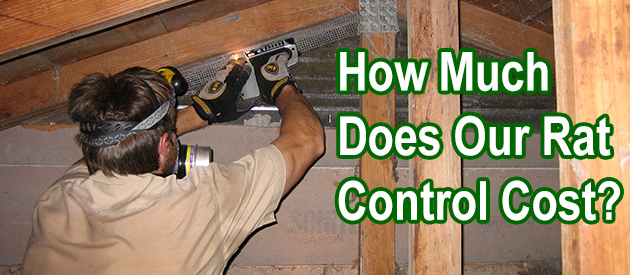Marion County, Indianapolis Rat Control Situation:
Hello David, I have been reading the information that you have on line about squirrels in the attic. We have something in our attic and cannot figure out what it is, nor have we been able to trap it, nor has it been caught in a rat trap. I hear this creature or creatures ??? during the day, as well as at night. There does not seem to be a particular favorite time that they move around. Perhaps the morning is very quiet, and there is more activity in the afternoon and evening. My bedroom is quite a distance from the area that we hear this creature in, so I would not hear it at night even if it is moving around a lot at night.
I mostly have heard scratching in the walls, and at one point did hear a big thud. The odd thing about this creature is this. We set a live trap with peanut butter in it, and what ever it is carried large pieces of insulation inside the trap to cover the peanut butter. Like really large- maybe a 6 X 6 inch piece. We feel the trap was not set properly because it did not shut. Next day we put meat in it, thinking it may be an animal that would want meat like an opossum. All this time our rat traps have remained in place but this creature DAILY overs all the traps with insulation....without getting caught. We have not seen anything enter or leave. We found one area that is gapping between he house and fascia but only maybe a 3" opening. We do know for sure that there is enter way at the garage floor. We will put foam insulation in those areas this weekend to hopefully stop rats or whatever it is up there from entering and will continue our trapping efforts. We live north of Indianapolis IN in the country on one acre. Our house is 7 years old; made of brick.
By my description, do you have any idea what we might be dealing with, and any suggestions on how to catch this creature? I appreciate all the info your web site; I just cant find anything that remotely sounds like what we have going on with this creature attempting to bury the traps with insulation. Many thanks for any advice. Jill
Why don't you have a wildlife expert inspect the house and attic in order to determine what the animal is? It could be raccoons or opossums, not necessarily rats. The feces and tracks in the attic, and the nature of the entry holes should tell you what animal you're dealing with.
Indianapolis Rat Control Tip of The Week
What Is The Cost Of Rat Removal?
Having rats in your home comes with the immediate need to get them removed if you don't want them to cause damage that you can't afford. And to remove them permanently, you have to get it done properly.
The first thing you need to do is hire skilled professionals. We have seen many homeowners choose pest control companies where they are asked to pay a sum monthly just to remove the rats in their homes without getting the results they desired.
You can't afford to make the same mistake. If you want to hire a professional to help remove the rats in your home, you need to choose a wildlife removal service. Apart from getting rid of the rats in your home, they will find and seal off all possible entry holes and prevent further reentry. With their services, you will be able to get it done once and for all.
There is no exact fixed cost for removal. The amount you will be paying depends on several factors. Ideally, if the rat problem you are having in your home is not a complex one, the total cost of removing the rat might run between $300 to $500.
The cost of a rat removal service depends on the part of the country you reside in, the number of rats that need to be removed, the number of service traps that will be needed to remove all the rats, the number of repairs that need to be done, and if cleanup is needed after removing the rats.
The initial cost you will have to pay might seem expensive but you need to understand the fact that it is worth it.


